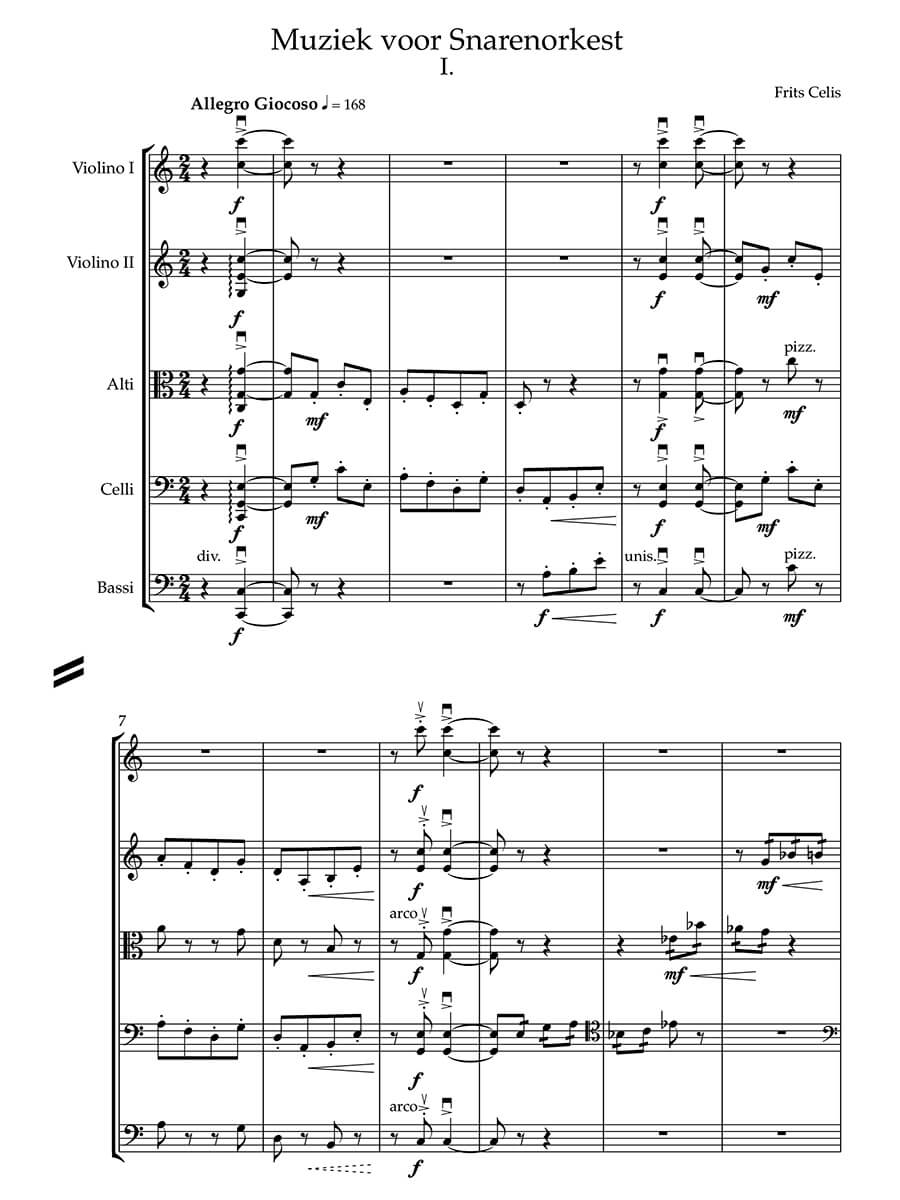Muziek voor strijkers, op. 1 & Musica a quattro mani, op. 1b (Set of full score, 5 string parts, 2 piano performance scores / first print)
Celis, Frits
50,00 €
Preface
Frits Celis – Music for strings, op. 1(1950) & Musica a quattro mani, op. 1b (1994)
(Antwerp, 1929)
Music for strings, op. 1
Frits Celis received a very thorough music education as a harpist, composer and conductor. At the Royal Conservatories of Antwerp and Brussels he obtained degrees in music theory, harmony, counterpoint, fugue, music history, harp and orchestral conducting. Afterwards, he also took courses at the Mozarteum in Salzburg and at the Staatliche Hochschule für Musik in Cologne to perfect his conducting skills.
In 1946, he began his career as a harp player at the Royal Flemish Opera in Antwerp, which prepared him for his career in conducting. After being made a laureate of the conducting contests at the Théâtre Royal de la Monnaie in Brussels and the NIR (the national broadcasting corporation), he became a conductor at La Monnaie in 1954 and stayed there until 1959. He then became the conductor and later the music director of the Royal Flemish Opera, where he conducted a broad international repertoire and different world creations of Flemish operas.
In addition to all this, he also performed as a guest conductor in the Netherlands, France, Germany, the Czech Republic, Slovakia, Spain and the United States. In 1960, Celis became the teacher of music theory at the Royal Flemish Conservatory of Antwerp, where he would later also teach transposition.
Parallel to his demanding career as a conductor, from 1949 onwards Celis worked on creating a precious oeuvre. This consists of songs, pieces for choir, chamber music and orchestral compositions. Except for a brief period in the first half of the seventies, when he leaned towards serialism, his work bathes in atonality. He avoids cerebralism and pays great attention to lyricism, expressiveness and a clear structure. Through his craftsmanship and integrity Celis wants to constantly communicate with his audience: he wants to be heard.
After the reorganization of the Antwerp Opera in 1988, Celis ended his career as conductor, choosing to dedicate more time to composing and thus significantly expanding his oeuvre.
As a conductor, composer and musicographer, Celis was particularly committed to pieces by Flemish composers, both contemporary and from the past. In addition to the many creations and rediscoveries he conducted, he put together suites from forgotten operas by August De Boeck, and he published about Flemish music and composers, especially about Edward Keurvels and August De Boeck.
Celis composed this Music for strings, op. 1 when he was twenty; in 1994 he adapted it as Musica a quattro mani, opus 1b and dedicated it to the Piano duo Kolacny. The brothers Stijn and Steven Kolacny recorded the work for their eponymous CD Musica a quattro mani (Eufoda 1244, 1996).
Frits Celis wrote the following about his Opus 1:
“The first of the three movements proceeds at a very fast pace and exhibits an upbeat character. Towards the end, the secondary theme is resumed more slowly to form the transition to the middle movement: a series of free variations on a theme of barely four bars. Here, boisterous passages are alternated with more lyrical ones. The whole leads to a climax that in turn expands into a rather dreamy atmosphere. The strong start of the last movement creates a stark contrast to this. To switch it up, this movement takes on a more playful character. The reprise of the opening material ultimately leads to a compelling conclusion.”
Duration of the piano version: 12’18”.
Jan Dewilde (with thanks to Frits Celis)
This score was edited by Edmond and Stijn Saveniers, in consultation with the composer, and published in collaboration with the Study Centre for Flemish Music (www.svm.be). The autographic manuscripts are kept in the library of the Royal Conservatory in Antwerp.
Read German and Flemish preface > HERE
Score Data
| Special Edition | The Flemish Music Collection |
|---|---|
| Genre | Chamber Music |
| Size | 225 x 320 mm |
| Specifics | Complete Performance Set: 1 score, 5 string parts & 2 piano performance scores |
| Printing | First print |
| Pages | 245 |
